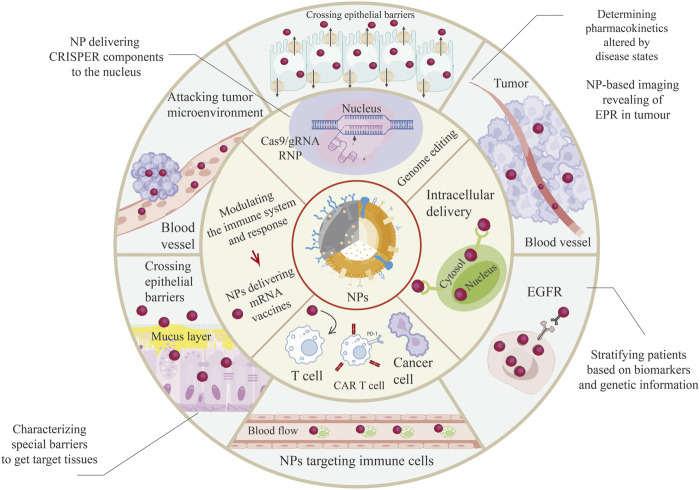FIGURE 2.
A broad range of applications of Nanoparticles (NPs) in the field of lung cancer treatment. NPs have been increasingly used to improve drug delivery and enhance the effectiveness of precision medicine. NPs can overcome biological barriers such as the blood-brain barrier, which can limit the effectiveness of certain drugs. By encapsulating drugs in NPs, it is possible to improve their solubility, bioavailability, and stability, and target them to specific cells or tissues. For instance, RNA nanoparticles (RNPs) have shown promise in delivering therapeutic RNAs such as siRNA and miRNA for the treatment of various diseases, including cancer and genetic disorders. Similarly, guide RNA (gRNA) delivered via NPs has been used in gene editing applications such as CRISPR-Cas9. Enhanced permeation and retention (EPR) is another mechanism that NPs can exploit to improve drug delivery. EPR takes advantage of the leaky blood vessels and poor lymphatic drainage of tumors to accumulate NPs at the tumor site, allowing for targeted drug delivery and minimizing systemic side effects. Epidermal growth factor receptor (EGFR)-targeted NPs have also been used for targeted drug delivery to cancer cells, while chimeric antigen receptor (CAR) T-cell therapy uses NPs to engineer T cells to target and destroy cancer cells. They can be used to deliver CARs directly to T cells, stimulate CAR T cells to proliferate and persist in the body, silence genes that inhibit CAR T-cell function or promote their exhaustion, and deliver CAR T cells directly to the tumor site with enhanced specificity, efficacy, and safety of this promising cancer treatment. Overall, the use of NPs in precision medicine applications holds great promise for improving drug delivery and enhancing the effectiveness of precision medicine therapies.

